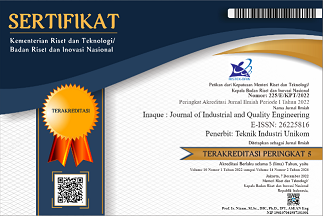IDENTIFIKASI POSTUR KERJA PENGRAJIN BATIK JUMPUTAN DENGAN METODE JOB STRAIN INDEX (JSI)
DOI:
https://doi.org/10.34010/iqe.v9i2.5278Abstract
UKM Batik Jumputan Ishak Palembang is one of the UKM that produces batik jumputan. Where all activities in the process of making batik jumputan are done manually by sitting and standing for a long time. These activities can pose a risk of injury to workers. The purpose of this study is to determine the level of ergonomic risk in jumputan batik workers and provide recommendations for improvement from the results of measuring the level of ergonomic risk in jumputan batik craftsmen. Ergonomics risk level assessment uses the Job Strain Index (JSI) method, where the JSI method uses six parameters, namely the intensity of effort use, duration of energy use, number of efforts per minute, hand position, work speed, and duration of activity per day. The results of the assessment show that the level of ergonomics risk based on the JSI method is that there are 7 work activities at a low risk level or the worker is safe with a JSI score 3, and there are 2 work activities at a moderate risk level with a JSI score 7, namely these activities have the potential to pose a work risk where activities that fall into the moderate risk category are the process of tasting cloth and picking cloth. For the improvement of work in the jumputan batik production process, additional work facilities such as tables and chairs can be provided which in the design consider anthropometric factors, so that the energy used at work can be reduced and can avoid the risk of work accidents.
Keyword: Ergonomic Risk, Work Posture, Job Strain Index (JSI)
Downloads
Published
Issue
Section
License
Authors who publish this journal agree to the following terms:
The author holds the copyright and grants the right of the first publication journal to enable INAQUE to share the work with acknowledgment of the author's work and early publications in this journal.
Authors may include separate additional contractual arrangements for the non-exclusive distribution of the journal's published version (for example, submit to an institutional repository or publish in a book), with the acknowledgment of its initial publication in this journal
Authors are permitted and encouraged to post their work online before and during the delivery process, as it may lead to productive exchanges, as well as quotations of previously published and longer works








